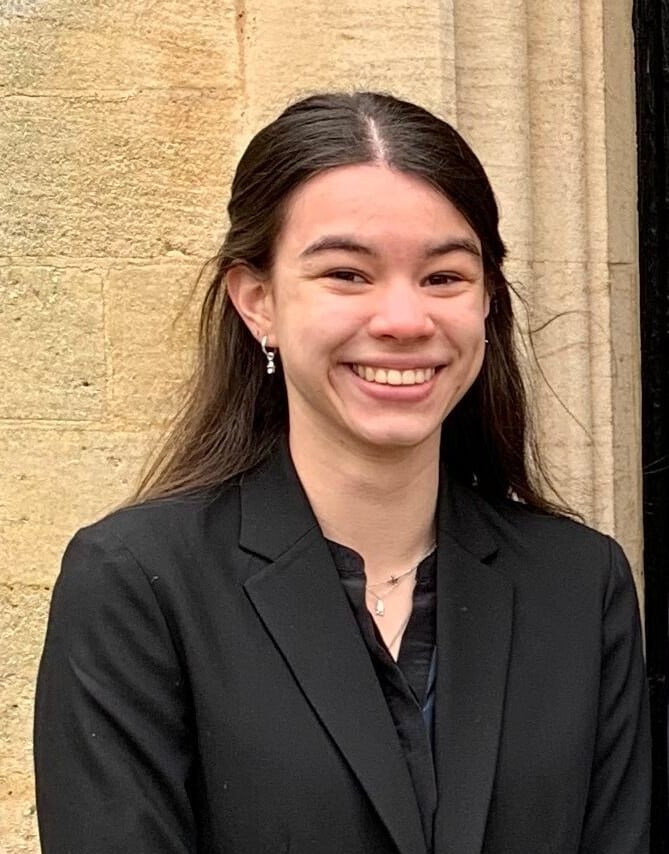Every year, Oakham School remembers 70 Old Boys and Masters who fell in the First World War, and 81 who died in the Second World War.
At a time before the expansion of the School, most of the pupils were local (Rutland and Leicestershire), and most strikingly, a lot of the soldiers were in the same Sports teams, Debating teams, and Houses.
In this feature, the School’s Archivist, Aurore Guillomot-Bonnefond uncovers some of the most extraordinary stories of family bond and friendship.
In this article:
- Family Connections
- School Teachers
- Rugby 1st XV, 1914
- Cricket 1st XI 1911
- Rugby 1st XV 1937
- 1943 Casualties
- Oakham School Archives
Five Bank House boys fought and lost their lives in France.
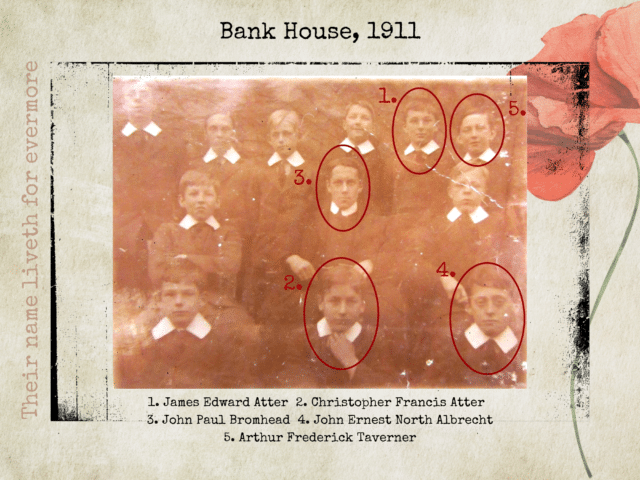
The Atter family lived in Melton Mowbray. They lost their two sons in the war. The older, James, enlisted on the day the war against Germany was declared. His younger brother, Christopher, enlisted aged 16, and chose not to come back to Oakham School after Form 5.
The Albrecht family lived in Stamford. They lost John and his older brother Charles in the war. Charles fought with the South Lancashire Regiment and landed in France as part of the British Expeditionary Force, under the command of Sir John French. Charles is the first Old Boy to have been killed in the conflict.
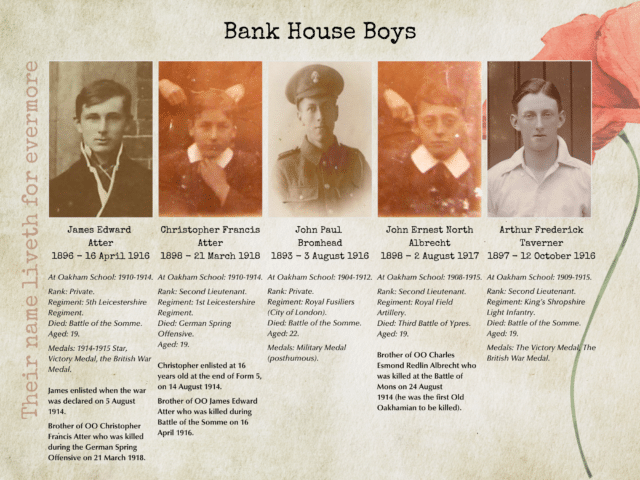
John Bromhead lived with his family on West Road, Oakham. His name is well known amongst Oakhamians for two reasons: it appears on the Head Prefects’ board in the Barraclough, and it is carved on the Thiepval Memorial, visited every year by Form 3 pupils.
Arthur Taverner’s father was Reverend of St John’s Rectory, Stamford, then of Wing Rectory, Oakham. Arthur attended RMC Sandhurst as soon as he left School. He landed in France in April 1916, and he was killed by a German machine gun only four months later.
Family Connections
Oakham School has a strong tradition of welcoming siblings, family members and children of Old Oakhamians. In the First World War, Oakham School and local families lost brothers – James and Christopher Atter, Charles and John Albrecht, Donald and Malcolm Neilson.
The Sills family mourned the loss of two cousins, Charles who was killed in the First World War, and Frederick who fought in the Second World War. Martha Reid Gough lost her husband Harry at the Battle of the Somme (1918), and her son Henry in Malta (1942).
The Neilson family lived in Lyddington at the turn of the century, and their older son Donald attended Oakham School for only a year as a Day Boy (Form 1). His younger brother, Malcolm, spent five years at Oakham School as a boarder in School House. Malcolm was studying at Ontario Agricultural College when the war broke out. He enlisted with the Canadian Army and landed in France in January 1915. Malcolm is well remembered by current pupils who visited Vimy Ridge, where he was killed by a shell, at the age of 22.
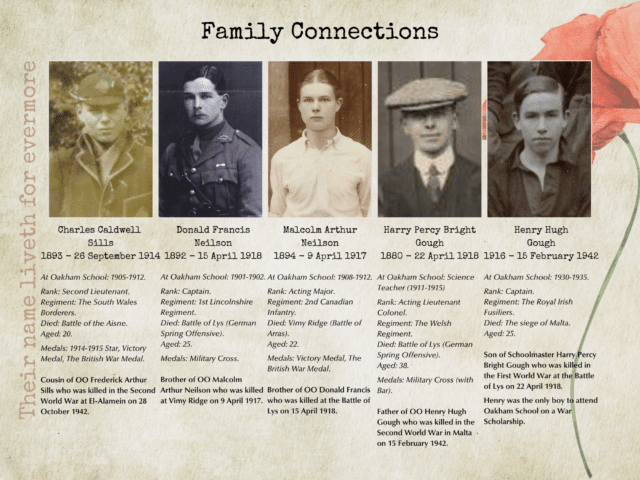
The turn of the century saw the Sills brothers and cousins studying at Oakham School. Three of them fought in the First World War, two survived. Charles was one of the first Oakhamian casualties. His cousin Frederick attended Oakham School between 1915 and 1922. He was a boarder in Junior House (Chapmans) and School House. Frederick served with The Argyll and Sutherland Highlanders in France in 1940, and was sent to North Africa. He was killed at El-Alamein, aged 34. His two sons, Charles and Richard, attended Oakham School.
Harry Gough started working at Oakham School as a Science teacher in 1911. Before he enlisted in 1915, he had also fulfilled the roles of Master of Rugby, Commanding Officer of the OTC and teacher in charge of the Debating Society. Harry was injured by shell splinters on 13 April 1918 during the German Spring Offensive, and he died of his wounds nine days later. His son Henry was only 16 months old. He received a War Scholarship to attend Oakham School. After School, Henry went to RMC Sandhurst and joined The Royal Irish Fusiliers. He was killed in a bomb raid over Valetta, Malta on 15 February 1942.
School Teachers
On the panels of the War Memorial Chapel are carved four names of Oakham School Masters, alongside pupils they may have taught.
Harry Percy Bright Gough was a Science teacher at Oakham School for four years (1911-1915).
Edward George Langdale was Commanding Officer in the OTC between 1912 and 1914. He received his commission with the Leicestershire Regiment on the day the war was declared and he landed in France in February 1915. Edward was promoted to Captain of 5th Leicestershire Regiment B Company in July 1915. The B Company was at the time made up of former Oakham Territorials. After eight months on the front, Edward and the Leicester Regiment fought at the Battle of Loos. On 13 October 1915, Edward was killed at the Hohenzollern Redoubt, alongside four Old Boys. All five Oakhamians are remembered at the Loos Memorial, visited by Form 3 pupils every year: Edward George Langdale, Gordon Sanderson, Edward Cartwright Franks, William Inglis Johnson, Basil Fullelove West Mogridge.
Walking along with his pipe in his mouth, Captain Langdale might have been at a Field Day, as he calmly signalled his right platoon to keep up in line, with ‘Keep it up, Oakham’ as they crossed our trench. The line was kept, and so perfectly that many of the stragglers who had come back turned and went forward again with them. But once more as they were reaching the German front line came that deadly machine gun fire, and their gallant commander was one of the first to fall, killed with a bullet in the head.
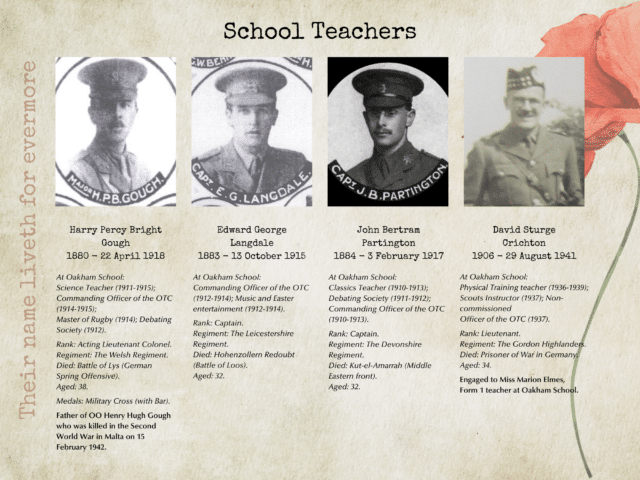
John Bertram Partington taught Classics for three years (1910-1913). He was also involved in the Debating Society, and was Second Lieutenant in the OTC. In 1911, he was the Commanding Officer of Basil Mogridge, Charles Sills and John Paul Bromhead. During the War, John fought in Lahore, Pakistan. He escorted German prisoners to Australia, then was posted in Mesopotamia with the Devonshire Regiment. He was killed in a shell explosion at Kut-el-Amarrah, at the age of 32.
David Sturge Crichton was a Physical Training (now P.E.) teacher at Oakham School between 1936 and 1939. He was appointed just as the new Gymnasium was completed. During his three years at School, David also joined the Scouts as Instructor in 1937, then the O.T.C. contingent as their new N.C.O. He regularly featured in the Masters’ Cricket team against the School’s 1st XI every summer and was a member of Oakham Cricket Club as well. When the war broke out, David joined the 1st Battalion Gordon Highlanders as Lieutenant and was sent to France with the B.E.F. He fought in Normandy in June 1940, where his battalion was captured. David died of cancer in a military hospital in Friesburg, Germany as a Prisoner of war on 29th August 1941.
Rugby 1st XV, 1914
As seen on the Bank House photograph, Old Boys who fell in the First World War were in the same houses, teams and societies. The impact of the conflict and loss suffered by local families is felt even more strongly when looking at the Rugby 1st XV 1914.
Eight of the players and Master were killed only a few years after the photograph was taken. However, the friendship and camaraderie were not limited to the rugby pitch. All players would have been boarders in School House for at least one year together.
Herbert Wait and Leonard Kingham were from the same city, both were boarders in Junior House (Chapmans), and they both joined The Royal Berkshire Regiment. Leonard, Herbert and John Albrecht all died at the Third Battle of Ypres. William Hill, Jack Dewar and Arthur Taverner showed their acting talent in The Frogs, part of the Easter Entertainment in 1914, and both Jack and Arthur fought at the Somme.
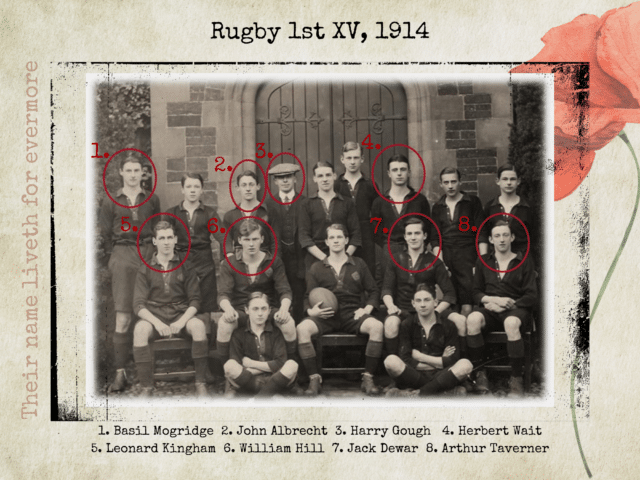
The Mogridge family lived in Melton Mowbray, where Basil’s father was the Reverend of Scalford Vicarage. As a boarder in School House (1910-1914), Basil showed abilities on the rugby pitch, on stage, and in the classroom. He was also in the School’s OTC contingent for three years. Basil had won an open scholarship at St John’s College, Cambridge to read Classics in September 1914. However, he never attended and enlisted in The Leicestershire Regiment. After about one year on the front, Basil and the 1st/4th Leicester Regiment fought at the Battle of Loos. On 13 October 1915, Basil was killed at the Hohenzollern Redoubt, alongside three Old Boys and a former Master. All five Oakhamians are remembered at the Loos Memorial, visited by Form 3 pupils every year: Edward George Langdale, Gordon Sanderson, Edward Cartwright Franks, William Inglis Johnson, Basil Fullelove West Mogridge.
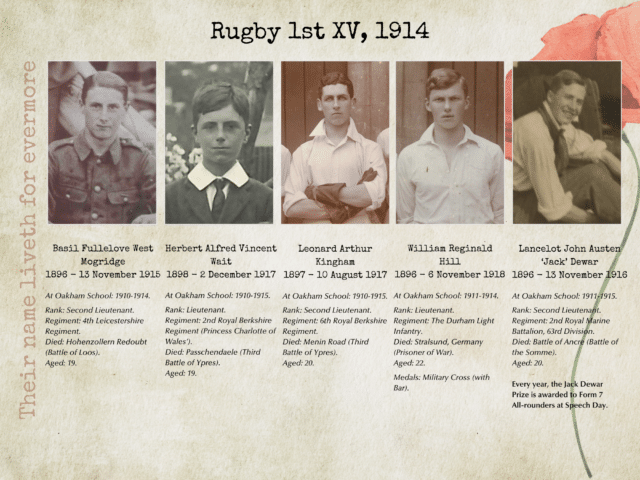
John Albrecht was a boarder in School House from 1908 to 1915. He was a keen rugby player, captaining the junior team in 1909, playing in the U14 XV for two years (1911-1912) and in the 1st XV in 1914. When he left Oakham School, John went to RMA Woolwich and joined The Royal Field Artillery in February 1916. His battalion fought in the third Battle of Ypres in Belgium where John died on 2 August 1917, at the age of 19. The Albrecht family mourned the death of John, three years after the loss of his brother Christopher.
Harry Gough started working at Oakham School as a Science teacher in 1911. Before he enlisted in 1915, he had also fulfilled the roles of Master of Rugby, Commanding Officer of the OTC and teacher in charge of the Debating Society. Harry left School in Spring term 1915 to join the 17th Welsh Regiment. He was sent to France in June 1916. He fought at Welsh Ridge, Bourlon Wood where he was injured by shell splinters on 13 April 1918 during the German Spring Offensive, and he died of his wounds nine days later at a Casualty Clearing Station at the age of 38.
Harry was awarded the Military Cross (with Bar) in February 1918 for conspicuous gallantry and devotion to duty.
“Throughout three days’ fighting he led the right of a successful counter-attack and succeeded in regaining a lost position. When his commanding officer was wounded he commanded the battalion with great ability and successfully brought them out of action”.
Herbert Wait was a boarder in Junior House (Lower School), then in School House (Middle and Upper School). He played rugby alongside John Albrecht in the U14 XV in 1912, and in the 1st XV in 1914. He also played in the Cricket 1st XI for two years, played Fives as a pair with Christopher Atter in 1914, and took part in various events on Sports Day, winning the U15 220 yards handicap in 1913, the U16 long jump and Quarter-Mile in 1914, and finally the 100 yards and long jump in 1915. He was involved in the Debating Society for three years, and gained Higher Certificates at Oxford and Cambridge School Examination board in his last term. Herbert went to RMC Sandhurst and joined the 2nd Royal Berkshire Regiment (Princess Charlotte of Wales’s) in 1915. His battalion fought in Belgium and Herbert was killed at the third Battle of Ypres on 2 December 1917 at the age of 19.
The Kingham and Wait families both lived in Reading. Leonard joined Junior House (Chapmans) in 1910, where Herbert was already a boarder, then went to School House until 1915. Leonard played as a forward in the Rugby 1st XV in 1913 (as a substitute) and 1914, and he was also a player in the Cricket 2nd XI in 1914 and later in the Cricket 1st XI in 1915, captained by Jack Dewar. In his last year, Leonard was a School prefect, alongside Herbert Wait. Leonard went to RMC Sandhurst and joined the 1st/6th Royal Berkshire Regiment in 1915. His battalion fought in Belgium and Leonard was killed at the third Battle of Ypres on 10 August 1917 at the age of 20.
William Hill attended Oakham School for three years (1911-1914). He was in the Cricket 1st XI, first as a substitute in 1912, then as a stalwart in 1913 and 1914. He was also a key player of the Rugby 1st XV for three seasons (1912 to 1914). William was seen on stage in the production of Aristophanes’ The Frogs in 1914, and served the School as Prefect in his last year. William showed great promise in the classroom as well, as he gained a Senior County Scholarship in 1913, Higher Certificates at the Oxford and Cambridge Examination board and an Open Exhibition at Corpus Christi, Cambridge in 1914. However, William never attended and joined The Durham Light Infantry shortly after the war broke out. He served in France for three years and he was captured on the Chemin des Dames on 27 May 1918, whilst in the 8th Battalion. William died of wounded as a Prisoner of War in Germany on 6 November 1918 at the age of 22.
William was awarded the Military Cross (with Bar).
“While a raiding party who had secured a prisoner were withdrawing under heavy machine gun fire and bombing, this officer rushed forward and picked-up one of his wounded from enemy wire, so that the enemy might not secure an identification. He had previously carried out several daring patrols and shown fine leadership.”
Jack Dewar’s father was the Reverend of Holy Trinity Vicarage, Loughborough. He was a boarder in School House for four years between 1911 and 1915. In his time at Oakham School, Jack took part in the Debating Society, performed on stage with William Hill in the production of Aristophanes’ The Frogs, and appeared in Fives competitions between 1912 and 1914. He was a stalwart in the Cricket 1st XI from 1913 and Captain the side in 1915. On the rugby pitch, he played in the 1st XV as a three-quarter for four years, captaining the side during his last term in Winter 1915. Jack also represented his house in the swimming inter-house in 1914 and won the six-length race. He was awarded the English Composition and Form 6 History prizes at Speech Day 1915. Jack was a Prefect in his last year, and Head Prefect in Winter 1915. When he left School in December 1915, Jack joined The Royal Marin Light Infantry. His Battalion landed in France on 8 July 1916 and fought in the Battle of the Somme, at Beaucourt-sur-L’Ancre, where Jack died of wounds in no man’s land at the age of 20 (less than a year after leaving School). Every year, Form 3 pupils hold a memorial service in the Ancre British Cemetery and lay a wreath on Jack’s grave. After the war, Jack’s parents asked the School to award each year a prize in honour of their son. The Jack Dewar prize has been awarded to Form 7 all-rounders ever since. The Dewar family lost two sons in the war; Jack’s brother, Sonny, was killed in action in France.
The Taverner family lived in Stamford, and then moved to Oakham when Arthur’s father became Reverend of Wing Rectory. Arthur was a boarder in Junior House (Chapmans) and Bank House from 1909 to 1915. He played in the Rugby 1sy XV as a full-back in 1914 and was in the Cricket 1st XV in 1915, captained by Jack Dewar. He was a keen runner, competing in the U15 220 yards in 1912, and in the Cross Country Steeplechase in 1914 and 1915. Alongside William Hill and Jack Dewar, Arthur also performed in the production of The Frogs in 1914. Arthur was a Prefect and Head Musician in his last year, and gained Higher Certificates at the Oxford and Cambridge Examination board in 1915. When he left School, Arthur attended RMC Sandhurst. He landed in France in April 1916, and he was killed by a German machine gun only four months later on 12 October 1916, whilst in charge of a night working party.
Cricket 1st XI 1911
When looking at the photograph of the Cricket 1st XI 1911, one cannot help but feel the impact of the First World War on the small School community. Six of the players, including the Captain, were killed only a few years after the photograph was taken. However, the friendship and camaraderie were not limited to the cricket field.
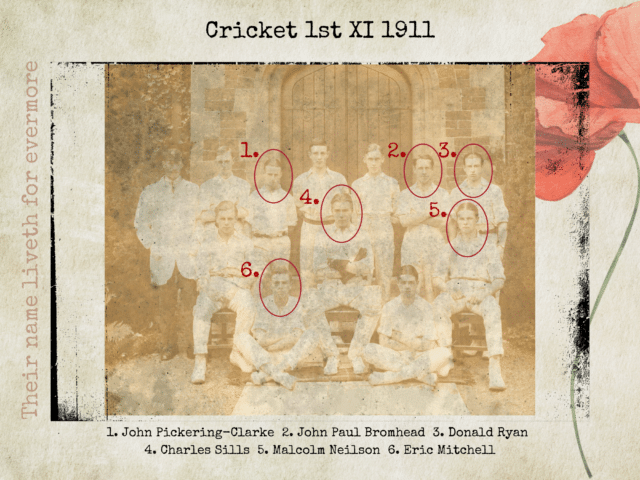
The Pickering-Clarke family lived in Leicester and their two sons, John and Eric, were boarders in School House. Over his four years at School, John played rugby in the U14 XV (1907) and the 1st XV (1909), and he was in the Cricket 1st XI (1910-1911). John served in the 10th Leicestershire Regiment and arrived in France on 7 July 1916. He was killed only one week later at the Battle of Bazentin (Somme) at the age of 22. His name is carved on the Thiepval Memorial, visited every year by Form 3 pupils. John’s older brother, Eric, fought in the war and enjoyed a 31-year long career at Oakham School (1919-1950) as teacher of Form 4, Master in charge of Cricket and Rugby, Housemaster of Junior House (Chapmans), and Second Master (Senior Deputy Head).
John Paul Bromhead lived with his family on West Road, Oakham. He spent eight years at Oakham School, boarding in Bank House and School House. John was a keen sportsman. He played in the Cricket 1st XI in 1911 and 1912, in the Rugby U14 XV in 1906 and 1907, and in the 1st XV from 1908, captaining the side in 1911. John represented his house on Sports Day and won the Mile, the Quarter-Mile and the 110 yards races in 1911. He was part of the School’s OTC contingent commanded by John Partington in 1911, alongside Eric Mitchell, Basil Mogridge, Charles Sills and Donald Ryan. John Paul was awarded several Speech Day prizes, including the Latin Composition and the Divinity prizes in 1909, 1911 and 1912, and the English Composition prize in 1910, 1911 and 1912. John served the School as a Prefect for two years (1909-1911), and as Head Prefect in his last year. John Paul gained Higher Certificate at the Oxford and Cambridge Examination board with Distinction in Scriptures and History in Summer 1912. John had gained a BA in the Classical Tripos at Sidney Sussex College, Cambridge when the war broke out. He joined the 8th Royal Fusiliers (City of London) and fought from 1 July 1916 at the Somme. He was killed near Pozières on 3 August 1916 at the age of 22. His name is carved on the Thiepval Memorial, visited every by Form 3 pupils.
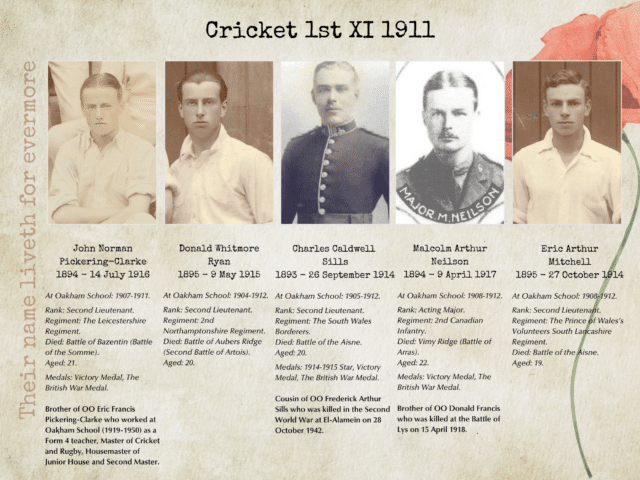
Donald Ryan came to Oakham School as a boarder in School in 1904. Over his eight years at School, he took part in the Debating Society (1910-1912), in the choir (1909-1912), and in the OTC. Donald played Fives in Junior and Senior competitions and was paired with Malcolm Neilson in 1910. He played in the Rugby 1st XV for three years and was named Captain in 1912. He played in both the Cricket 2nd XI (1909 and 1910) and Cricket 1st XI (1911 and 1912). Donald was also seen running on Sports Day, winning the Quarter-Mile and Quarter-Mile handicap in 1912. Donald joined the 2nd Northamptonshire Regiment and landed in France in November 1914. He was killed in action in Flanders, Belgium, on 9 May 1915 at the age of 20.
Charles Sills attended Oakham School for seven years (1905-1912). He was a stalwart of the Cricket 1st XI for five seasons, and captained the team in 1911 and 1912. He also played in the Rugby 1st XV in 1910 and 1911. He took part in Fives Junior and Senior competitions from 1908, and won the Senior Cup with Malcolm Neilson in 1912. On Sports Day, he proved himself a specialist high jumper, winning the U15 event in 1907, and the senior event in 1910, finishing second in 1911 and 1912. Charles was a School Prefect in his last year. After School, Charles went to RMC Sandhurst and joined The South Wales Borderers in 1913. When the war broke out, he was sent to France as part of the 1st Division of the B.E.F. and fought at Mons and the Marne. He was killed on 26 September 1914 at the Aisne.
Malcolm Neilson spent five years at Oakham School, as a boarder in School House. He was a keen Fives player, winning the Senior Cup with Charles Sills, played in the Cricket 1st XI for three seasons (1910-1912) and played as a centre three-quarter in the Rugby 1st Xv in 1911. Malcolm also took part in the Debating Society from 1910 to 1912, he sang in the choir for two years (1910-1912) and served the School as Prefect in his last year. Malcolm was studying at Ontario Agricultural College when the war broke out. He enlisted with the Canadian Army and landed in France in January 1915. Malcolm is well remembered by current pupils who visited Vimy Ridge, where he was killed by a shell, at the age of 22.
“He was not only admired and respected, he was loved. It was generally conceded that he was one of the most able and efficient officers in the battalion. But to those of us who knew him intimately, who lived and worked with him, he was not only an exceptionally able soldier, but a gentleman of the first water. He lived his life with a definite purpose for usefulness. He was clean in thought, word, and action. He had a clear conception of the obligations of life, and, with benefit to all who came in contact with him, he tried with success to carry them out.”
Eric Mitchell’s family lived in Gosport, Hampshire and his father had been rector of Wing Vicarage, Oakham. Eric was a boarder in School House between 1908 and 1912. He sang in the choir throughout his four years at School. He played at half-back or three-quarter in the Rugby 1st XV for three seasons (1910-1912), won the Fives Senior competition in 1912 and played in the Cricket 1st XI in 1911 and 1912. Eric also served the School as Prefect in 1912. He was in the OTC contingent, and was promoted to Sergeant in his last year. Eric went to RMC Sandhurst and joined the 2nd Prince of Wales’s Volunteers South Lancashire Regiment. He landed in France with the B.E.F. on 14 August 1914 and fought at the Aisne. Eric was killed at Neuve Chapelle two months after his teammate Charles Sills on 27 October 1914 at the age of 19.
Rugby 1st XV 1937
Out of the 81 Old Boys who died in the Second World War, four played in the same rugby team in 1937.
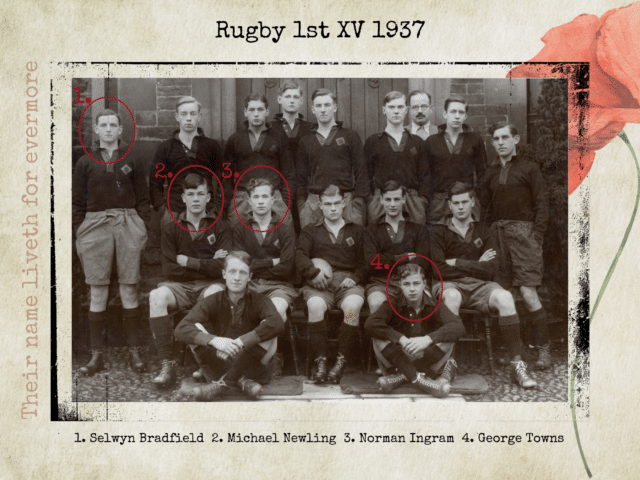
The Bradfield family lived in Nottingham and all three sons were boarders in School House. Selwyn, the youngest, spent four years at School (1934-1938). He was a keen cricketer, playing in the U14 XI in 1934, and in the 1st XI for three seasons (1936-1938). He played in the Rugby 1st XV in 1937 and also played both cricket and rugby for Nottinghamshire Public Schools in 1937-1938. He was promoted to CSM in the OTC in 1938, and was in the School’s shooting team from 1936 to 1938. Selwyn served the School as Prefect in 1938. He went to RMA Sandhurst and joined the 1st Leicestershire Regiment. Selwyn fought on the South-East Asian front and was missing, presumed killed in action during the Japanese invasion of Malaysia on 15 December 1941 at the age of 21.
Norman Ingram attended Oakham School between 1932 and 1937 and was a boarder in Wharflands. During his five years at School, Norman played in the first teams for cricket in 1937, hockey in 1935 and rugby in 1936 and 1937. He appeared in two drama productions in 1934 and 1936 and was promoted to CSM in the OTC in 1937. He received the History prize on Speech Day 1935 and served the School as Prefect in 1937. Norman joined the 8th Duke of Wellington’s Own Regiment, which was converted to 145 Regiment Royal Armoured Corps in 1941. Norman fought in North Africa and took part in the Italy landings in September 1944. He was killed at Coriano Ridge on 18 September at the age of 25.
“He was the most popular officer in the Regiment with officers and men. His men had the greatest confidence in him and affection for him, and every officer had a genuine admiration for his ability, his equanimity, his good humour and broadminded, tolerant geniality.”
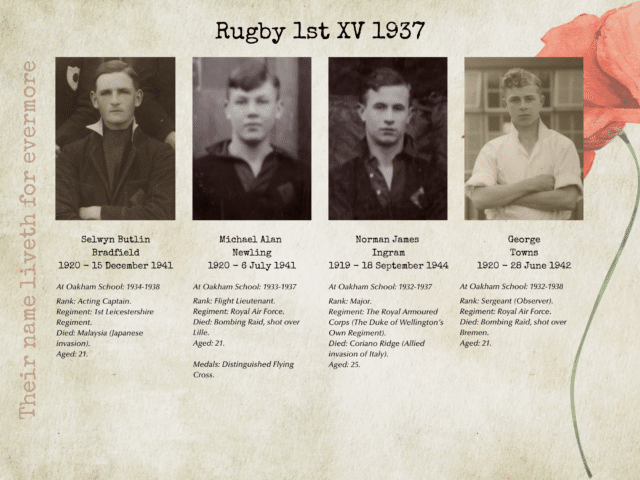
George Towns lived with his family in Whissendine, Rutland. Both he and his younger brother Richard attended Oakham School as Day Boys. Between 1932 and 1938, George proved to be a talented runner, winning the Senior Steeplechase in 1937, and finishing second in the Half-Mile and the Mile at Sports Day 1937. He represented the School in the Cricket 2nd XI for two seasons (1937-1938), and in the 1st XI in 1937. George was awarded the Form 3 Trustees’ prize at Speech Day 1933, and the Form 4 French prize in 1935. George was working at Barclays bank when the war broke out and he joined the Royal Air Force in January 1941. He took part in many bombing operations before his aircraft was shot down and crashed at Westrum Kreis Meppen on 28 June 1942. His brother Richard fought in the war in the Royal Air Force Volunteer Reserve and survived.
Michael Newling was the eldest of six children and lived with his family in Surrey. He was a boarder in Wharflands between 1933 and 1937, at the same time as Norman Ingram. Michael was an excellent swimmer, winning the two-length free style and two-length breaststroke races in the Swimming Sports 1937, and finishing second in the two-length backstroke and four-length free style races that same year. He played in the Rugby 1st XV for two seasons (1936-1937), as well as in the Nottinghamshire Public Schools in 1937. In the OTC contingent, he was promoted to Sergeant in 1937, and took part in shooting in the Country Life Competition, paired with Norman Ingram. When he left School, Michael emigrated to New Zealand, but came back home nine months later in autumn 1938. He started his training with the Royal Air Force in January 1939 and his squadron was sent to France in May 1940. He took part in the Battle of Britain and the fighting over Dunkirk in 1940. On 6 July 1941, his Spitfire was shot down over Lille and Michael was declared missing, believed killed. Michael was awarded the Distinguished Flying Cross.
“This officer has been continuously engaged in active operations since May 1940 and has at all times marked courage and leadership. On one occasion during an attack against a large force of enemy bombers, he was shot down into enemy territory, but with great determination, succeeded in gaining his own lines. Flight Lieutenant Newling has destroyed at least three enemy aircraft and assisted in the destruction of several more.”
1943 Casualties
On 11 November this year, services will be held in houses, led by Housemasters and Housemistresses, and Heads of House. Houses will remember nine boys, who died 80 years ago. Their names will read out before the minute of silence.
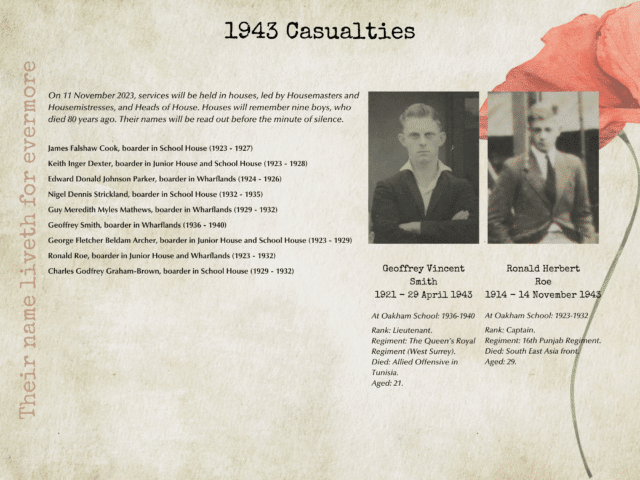
James Falshaw Cook was a boarder in School House between 1923 and 1927. During his time at School, he gained his Certificate ‘A’ in 1926, and was promoted to the rank of Corporal in the OTC. He also took part in the Debating Society in his last year. James worked in the Engineering industry and enlisted the Royal Air Force in 1935. He took part in several bombing missions during the war. On 14 February 1943, on a bombing raid to Köln, his aircraft was shot down by a night flyer and crashed near Limburg, Belgium. James was 34 years old.
Keith Inger Dexter attended Oakham School from 1923 to 1928, and he was a boarder in Junior House (Chapmans) and School House. He was in the OTC contingent and gained his Certificate ‘A’ in 1927. He played in the first violins’ section in the Orchestra from 1926. Keith was a three-quarter in the Rugby 1st XV in 1928, and ran in School House’s winning relay team at Sports Day 1928. When the war broke out, Keith had been working as an Inspector in the Metropolitan Police. He joined the Royal Air Force Volunteer Reserve in 1941, then later enrolled in the Air Training Corp. His aircraft was shot down on 16 June 1943 on operations against Köln. Keith was declared missing and presumed dead, at the age of 32.
Edward Donald Johnson Parker spent two years in Wharflands (1924-1926). During his short time at School, Edward played in the Rugby U14 XV in 1924, and gained his School Certificate in 1926. After school, Edward became a bank clerk. He volunteered for the Royal Air Force on 1 September 1939 and was called up on 28 October 1939. Edward died on 17 January 1943 while flying a Lancaster with 61 Squadron during a raid on Alexander Platz Railway Station, Berlin. He was 32. Edward was awarded the Empire Gallantry Medal in august 1940, which was then exchanged for the George Cross. He was also awarded the Distinguished Flying Cross in November 1940 for “carrying out 43 operational flights against the enemy”. He received the 1939-1945 Star, the Air Crew Europe Star, the Defence Medal 1939-1945 and the War Medal 1939-1945.
Nigel Dennis Strickland lived with his family in Harrogate, Yorkshire. He came to Oakham School in 1932 as a boarder in School House, and left in 1935. He was in the Scouts during his first year at School, than joined the OTC contingent. He gained his Certificate ‘A’ in 1935. Nigel enlisted in The Leicestershire Regiment. His regiment was sent in the Mediterranean and landed on the south-east tip of Sicily. Nigel was killed in action on 15 July 1943 at the age of 24, only eight months after the birth of his son.
“He was killed instantly, leading an attack. His fearlessness was superb and remained a splendid encouragement to his men. He was the first man to reach the enemy position; the result was that the Company gained their objective, a German HQ. Had he lived he would have received the M.C.”
Guy Meredith Myles Mathews attended Oakham School between 1929 and 1932 as a boarder in Wharflands. He was a member of the Philatelic Society in 1931 and of the Debating Society in 1932. He was awarded the Form 4 Mathematics prize at Speech Day 1930, and the Lower Form 5 Science prize in 1931. He was in the OTC contingent, and gained his Certificate ‘A’ in 1932. Guy was working as a solicitor before the war. He served with the 5th Royal Inniskilling Dragoon Guards and was sent in Palestine in January 1940. He then joined the 8th Armoured Bridage in North Africa. He fought at the battles of Alam Halfa and El-Alamein, and was killed near Dur Umm-Er Rami Ridge on 15 January 1943, at the age of 27.
Geoffrey Smith was a boarder in Wharflands between 1936 and 1940. He represented his house in the light-weight Boxing competition in 1937 and at Sports Day, finishing second in the Quarter-Mile handicap in 1938. Geoffrey played rugby in the 2nd XV in 1938 and in the 1st XV for two seasons (1939 and 1940); he was also a key player in the Cricket 1st XI in 1940. He was in the OTC contingent for three years, and was promoted to CSM in 1940. He was prefect in Wharflands in 1940, and his name appears on the house prefect boards. He enlisted with The Queen’s Royal Regiment (West Surrey) as soon as he left School and saw action in France in 1940. He then joined the 56 London Division (‘Black Cats’) and was killed during the Allied offensive in north-eastern Tunisia on 29 April 1940 at the age of 21.
George Fletcher Beldam Archer lived with his family in Doncaster, Yorkshire. He attended Oakham School between 1923 and 1929, first in Junior House (Chapmans), then in School House. He played in the Rugby U14 XV in 1925, in the Cricket 2nd XI in 1929, and won the Junior Fives cup in 1928. He also took part in the Debating Society in 1929. In the OTC, he was promoted to the rank of Lance Corporal in 1929. George worked as an accountant in Saigon, Vietnam, and when the war was declared, he enlisted in the 1st Straits Settlements Volunteer Force (Singapore Volunteer Corps). George was captured by the Japanese when Singapore surrendered on 15 February 1942. As Prisoner of War, George was transported to Thailand on 13 May 1943 as part of a labour force building the Thailand-Burma railway. George died at Tamarkan, Thailand on 7 August 1943 at the age of 31.
Ronald Roe arrived at Oakham School aged 9 in 1923. He was in Junior House (Chapmans) and Wharflands, where he was a boarder until 1932. He represented both his houses at Sports Day, first in the junior sprint races (100 yards and 220 yards), then in the senior relay. He took part in the feather boxing competition in 1928. In the OTC, he was promoted to Lance Corporal in 1932. He was awarded the Form 1 English prize at Speech Day 1925 and the lower School Drawing prize in 1927. After School, Ronald went to live in China. When the war was declared, he joined the Punjab Regiment and fought in India, Burma and the Dutch East Indies. He was killed on 14 November 1943 at the age of 29.
Charles Godfrey Graham-Brown was in School House from 1929 to 1932. He was involved in the Debating Society in 1931 and appeared on stage in a production of The Little Man in 1932. At Speech Day 1930, he was awarded the Lower Form 5 English prize. After obtaining his MA in Edinburgh, Charles worked in a Literary Agency in London. When the war broke out, he joined the Royal Army Service Corps. Charles was killed on 17 June 1943, aged 28, when his ship, sailing for the invasion of Sicily, struck a mine and was sunk.
Oakham School Archives
The Archives Collection is full of team and house photographs. However, some gems are also kept in the boxes, especially informal photographs of pupils at School.
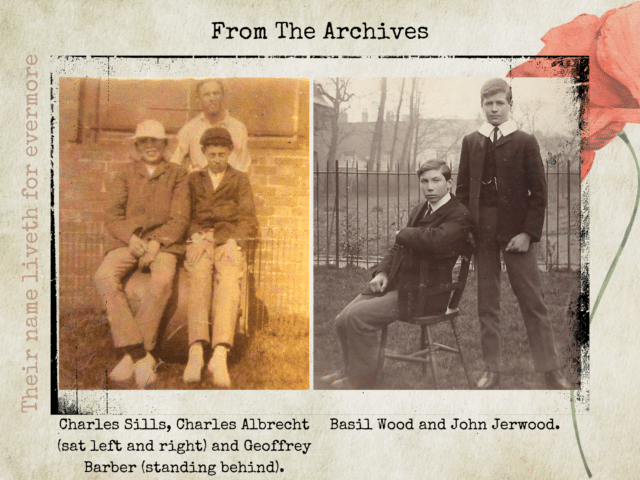
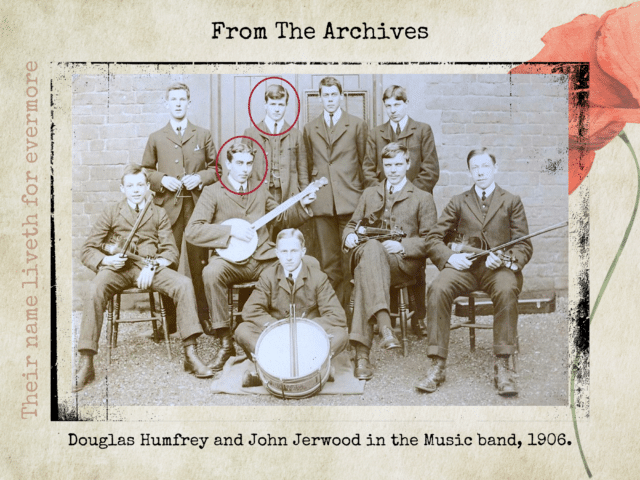
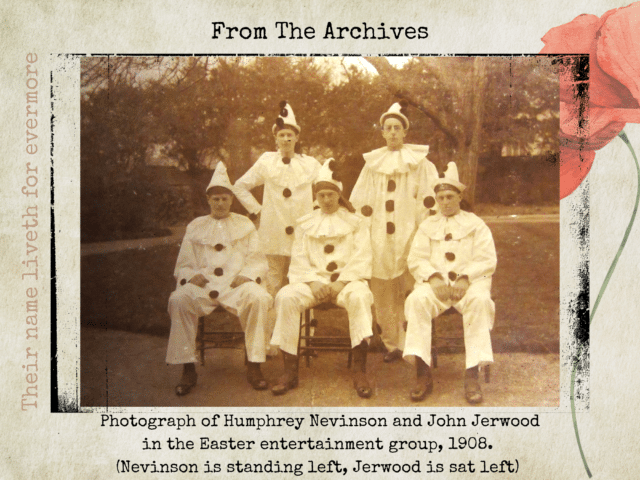
Basil Wood attended Oakham School for six years (1900-1906). He was a teammate of John Jerwood in the Rugby 1st XV in 1905, and of both John and Douglas Humfrey in the Cricket 1st XI in 1906. After School, Basil went to Sri Lanka to become a tea planter. When the war was declared, Basil joined the 6th Queen’s Own Royal West Kent Regiment and was sent to France in November 1915. He was killed at the Battle of Albert, at the Somme, on 3 July 1916 at the age of 28. His name is carved on the Thiepval Memorial, visited every year by Form 3 pupils.
Douglas Humfrey attended Oakham School between 1902 and 1907 as a boarder in School House. He served the School as Head Prefect in 1906-1907, as Head Musician for two years (1905-1907), and as Librarian (1904-1907). He was involved in the Debating throughout his five years at School. He played cricket in the 2nd XI for two seasons (1904-1905), and in the 1st XI for three seasons (1905-1907). He played as a forward in the Rugby 1st XV in 1905 and 1906, and joined the Shooting team in 1905. On Sports Day 1906, he finished joint second in the high jump event, equal with John Jerwood. Douglas obtained a BA at Lincoln College, Oxford and worked as a private tutor. He then joined the Oxfordshire and Buckinghamshire Light Infantry and held an appointment in Russia before going to France to serve in the First World War. He fought at the Battle of Aubers and was killed in action on 16 May 1915, aged 27.
Humphrey Nevinson’s family lived in Lyndon, Rutland and moved to Medbourne, Leicestershire in 1909. Humphrey attended Oakham School between 1905 and 1909 in School House. He played rugby in the 1st XV, first as a substitute in 1907, then as a stalwart forward in 1908. He took part in the Debating Society in 1908, and appeared in the Easter entertainment in 1908. He served the School as Prefect and Librarian in 1908. Humphrey enlisted in the Manchester Regiment and his battalion was sent to Alexandria in September 1914. Humphrey fought at the Suez Canal and took part in the Gallipoli landings. He was wounded during the Battle of Krithia on 4 June 1915 and was sent to the hospital ship Somali where he died of wounds a day later at the age of 23.
Humphrey wrote to his mother after being injured:
“My dear mother, just a line to let you know I am still very fit. I know you will always be anxious for news. That is why I just send a scrap. I really have no time for more, as we are frightfully busy now, digging day and night. I am a qualified navvy and engineer now. We are still attached to the Royal Fusiliers, and I am getting on very well. My best love to all and thanks for the letters dated May 13th. Your loving son HKB Nevinson.”
The Albrecht family lived in Stamford. Their eldest son Charles attended Oakham School between 1903 and 1911 in School House. He played Fives in Junior competitions, and was paired with Donald Ryan in 1907. Charles was in the Shooting team in 1908, and played rugby in the 1st XV for two seasons (1909 and 1910). He was a School Prefect in his last year and passed the Army Qualifying and the Sandhurst Competitive Examinations in 1911. He joined the South Lancashire Regiment (Prince of Wales Volunteers) in 1912. When the war was declared, his battalion became part of the B.E.F. under the command of Sir French. Charles was killed at the Battle of Mons early in the conflict at the age 21.
Geoffrey Barber was a boarder at Oakham School from 1905 to 1908. He played in the Rugby 1st XV as a forward in 1907, alongside Humphrey Nevinson and served the School as Prefect in 1908. Geoffrey joined the 2nd Yorkshire Regiment (Alexandra, Princess of Wales’s Own) in March 1909 and undertook Imperial Service Obligations on 4 August 1914. His battalion landed in France on 17 April 1915. Geoffrey was killed eight days later at the Battle of St Julien at the age of 25 (one day after Geoffrey Porter and Horace Ravenhill).

Geoffrey Porter attended Oakham School for only one term in Winter 1900. He emigrated to Canada in 1904 and became a farmer. On 17 September 1914, Geoffrey joined the 7th Canadian Infantry (British Columbia Regiment). His battalion went to France as part of the Canadian Expeditionary Force. Geoffrey fought in Belgium, and was killed at the Battle of St Julien on 24 April 1915 at the age of 30.
The Ravenhill family lived in Hughesdale, Victoria, Australia. Horace was a boarder in School House from 1903 to 1905. At School, he proved to be a keen swimmer, finishing second in the U15 two-length race in 1903 and winning the four-length handicap race in 1904. He also played in the Cricket 2nd XI in 1905. Horace studied at the Agricultural College of Canada. On 17 September 1914, he joined the 7th Canadian Infantry (British Columbia Regiment). His battalion went to France as part of the Canadian Expeditionary Force. Horace fought in Belgium, and was killed at the Battle of St Julien on 24 April 1915 at the age of 25.
The Oakham community extends beyond the School campus. We have explored in this feature various connections between Old Boys, at School and during the war.
One such extraordinary story of parallels is that of Geoffrey Porter and Horace Ravenhill, who enlisted in the same battalion on the same day, and were killed on the same day during the Second Battle of Ypres.
Follow this story on the Oakhamian Connection to find out more about the boys and their School Achievements.




